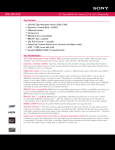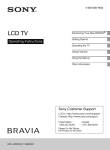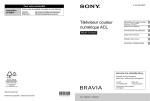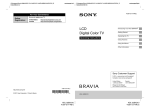Download LCD Digital Color TV - Manuals, Specs & Warranty
Transcript
Operating Instructions
LCD Digital
Color TV
Sony Customer Support
U.S.A.: www.sony.com/tvsupport
Canada: www.sony.ca/support
United States
1.800.222.SONY
Canada
1.877.899.SONY
Sony will work to resolve
your questions more quickly than your retailer.
KDL-32LL150
© 2009 Sony Corporation
Please Do Not Return
the Product to the Store
Owner’s Record
The model and serial numbers are located at the rear of the TV.
Record these numbers in the spaces provided below. Refer to
them whenever you call upon your Sony dealer regarding this
TV.
Model Name
Your BRAVIA TV is ENERGY STAR® qualified
in the “Home” mode.
It meets strict energy efficiency guidelines set by
the U.S. Environmental Protection Agency and
Department of Energy. ENERGY STAR is a joint
program of these government agencies, designed
to promote energy efficient products and
practices.
❑
Serial No.
CAUTION
To prevent electric shock and blade exposure, do not use
this polarized AC plug with an extension cord, receptacle or
other outlet unless the blades can be fully inserted.
❑
Operate the TV only on 120-240 V AC.
When the TV is initially set up, it is designed to meet
ENERGY STAR requirements.
❑ Changes to certain features, settings, and functionalities of
this TV (i.e. Picture/Sound, Power Savings) can slightly
change the power consumption.
Depending upon such changed settings, the power consumption
may increase which possibly could exceed the limits required for the
ENERGY STAR qualification.
Compatible Wall Mount Bracket Information
Use the following Sony WALL-MOUNT BRACKET with
your TV model.
Sony TV Model No.
KDL-32LL150
Licensing Information
Macintosh is a trademark of Apple Inc., registered in the U.S. and
other countries.
HDMI, the HDMI logo and High-Definition Multimedia Interface
are trademarks or registered trademarks of HDMI Licensing, LLC.
Fergason Patent Properties, LLC:
U.S. Patent No. 5,717,422
U.S. Patent No. 6,816,141
Manufactured under license from Dolby Laboratories. Dolby and
the double-D symbol are trademarks of Dolby Laboratories.
Blu-ray Disc is a trademark.
“BRAVIA”,
, BRAVIA Sync, and
registered marks of Sony Corporation.
are trademarks or
“PLAYSTATION” is a registered trademark and “PS3” is a
trademark of Sony Computer Entertainment Inc.
Sony
Wall-Mount
Bracket Model
No.
SU-WL500
Use with other WALL-MOUNT BRACKETS may cause
instability and could result in property damages or injury.
Cleaning
When cleaning, be sure to unplug the power cord to avoid
any chance of electric shock.
• Wipe the LCD screen gently with a soft cloth.
• Stubborn stains may be removed with a cloth slightly
moistened with a solution of mild soap and warm water.
• If using a chemically pretreated cloth, please follow the
instruction provided on the package.
• Never use strong solvents such as a thinner, alcohol or
benzine for cleaning.
• See the supplied Safety Booklet for additional
information.
This manual is for the 32 class BRAVIA KDL-LL150 series model with screen size measured diagonally. The 32 class has a 31.5 inch
viewable image size (measured diagonally).
2
Contents
Introducing Your New BRAVIA®
Wide Mode . . . . . . . . . . . . . . . . . . . . . . . . . . 26
Welcome to the World of BRAVIA® . . . . . . . . . 4
Wide Mode with PC . . . . . . . . . . . . . . . . . . . 26
Experiencing Stunning HD with Your
BRAVIA . . . . . . . . . . . . . . . . . . . . . . . . . . . 4
Using the Menus
The Four Steps to a Stunning HD
Experience . . . . . . . . . . . . . . . . . . . . . . . . .5
Navigating through TV Menus . . . . . . . . . . . 27
TV Feature Highlights . . . . . . . . . . . . . . . . . . . 5
Using the Sound Settings . . . . . . . . . . . . . . . 29
Getting Started
Using the Picture Settings. . . . . . . . . . . . . . . 28
Using the Screen Settings . . . . . . . . . . . . . . 30
Using the Channel Settings . . . . . . . . . . . . . 32
Setting Up Your TV . . . . . . . . . . . . . . . . . . . . .6
Using the Parental Lock Settings . . . . . . . . . 33
Locating Inputs and Outputs . . . . . . . . . . . . . .7
Using the Setup Settings . . . . . . . . . . . . . . . 36
Connecting the TV . . . . . . . . . . . . . . . . . . . . .9
Using the Photo Settings . . . . . . . . . . . . . . . 38
Connecting Other Equipment . . . . . . . . . . . . 12
Bundling the Connecting Cables. . . . . . . . . .13
Other Information
When Installing the TV Against a Wall or
Enclosed Area . . . . . . . . . . . . . . . . . . . . .13
PC Input Signal Reference Chart for
PC and HDMI IN 1/2/3 . . . . . . . . . . . . . . . 39
Securing the TV . . . . . . . . . . . . . . . . . . . . . . 14
Preparing the TV for Wall-Mounting . . . . . . . 40
Running Initial Setup. . . . . . . . . . . . . . . . . . .16
Troubleshooting . . . . . . . . . . . . . . . . . . . . . . 41
Operating the TV
Using the Remote Control. . . . . . . . . . . . . . .17
Important Notices . . . . . . . . . . . . . . . . . . . . . 45
Specifications . . . . . . . . . . . . . . . . . . . . . . . . 46
Index . . . . . . . . . . . . . . . . . . . . . . . . . . . . . . . 47
Remote Control Button Description . . . . . . .18
TV Controls and Indicators . . . . . . . . . . . . . . 20
Using Features
Using BRAVIA Sync with Control for
HDMI . . . . . . . . . . . . . . . . . . . . . . . . . . . .21
Inputs . . . . . . . . . . . . . . . . . . . . . . . . . . . . . . 21
Photo. . . . . . . . . . . . . . . . . . . . . . . . . . . . . . .22
Accessing Photo . . . . . . . . . . . . . . . . . . . . . .23
Using PIP Feature. . . . . . . . . . . . . . . . . . . . . 25
Favorites . . . . . . . . . . . . . . . . . . . . . . . . . . . . 25
Customer Support
United States
http://www.sony.com/tvsupport
Canada
http://www.sony.ca/support
On-line Registration
United States
http://productregistration.sony.com
Canada
http://www.SonyStyle.ca/registration
3
Introducing Your New BRAVIA®
Welcome to the World of BRAVIA®
Thank you for choosing this Sony BRAVIA® high-definition television. Use the
documentations listed below to get the most out of your TV.
Safety Booklet
Contains precautionary
measures to keep you and
your TV safe. Read this
information prior to setting up
your TV.
Quick Setup Guide
Provides TV setup information with sample
connection diagrams and TV features.
Operating Instructions
Provides the most detailed
information to operate your
TV.
Experiencing Stunning HD with Your BRAVIA
The quality of the image you see on your BRAVIA TV is only as good as the quality of the
signal it receives. To experience the stunning detail of your new BRAVIA TV, you need
access to HD programming. Your BRAVIA TV can receive and display HD programming
from:
•
•
•
•
Over-the-air broadcasting via HD-quality antenna
HD cable subscription
HD satellite subscription
Blu-ray Disc™ player or other HD compatible external equipment
Contact your cable or satellite provider for information on upgrading to HD programming.
4
The Four Steps to a Stunning HD Experience
Along with your BRAVIA TV set, a complete HD system requires an HD sound system, a
source of HD programming, and a proper connection setup. Refer to the Quick Setup
Guide, enclosed separately, for connecting optional equipment.
You can enjoy crisp, clear images, smooth
movement, and high-impact visuals from
1080 HD signals as shown here.
When you compare a high-definition signal
to a standard analog signal, you will notice
a big difference in picture quality. If black
bars appear as shown here, press WIDE
on the remote control to fill the screen.
TV Feature Highlights
Your BRAVIA comes with many convenient features, such as:
➢ BRAVIA Sync: Allows your BRAVIA TV to communicate with other Sony
equipment supporting the Control for HDMI function (page 21).
➢ Photo: View JPEG files from your USB connected equipment and enjoy photo
slideshows (page 22).
➢ PIP (Picture in Picture): You can work on your PC and watch your favorite TV
program simultaneously (page 25).
➢ Favorites: Your favorite channels and inputs are at your finger tips for easy
access (page 25).
➢ Auto Wide Mode: Set your TV to automatically adjust the screen based on the
signal resolution (page 26).
➢ Input Selection: Allows you to easily switch between the connected equipment
(page 21).
5
Introducing Your New BRAVIA®
Set, Sound, Source, and Setup
Getting Started
Setting Up Your TV
The TV is packaged with a detached Table-Top Stand so you can mount the TV to a wall right
away. If you are not mounting the TV to a wall, you will need to attach the Table-Top Stand. Use a
Philips screwdriver and the supplied screws to complete the task. Look for the attachment
instruction taped to the TV unit.
Be sure to consider the following while setting up your TV:
• Disconnect all cables when carrying the TV.
• Carry the TV with the adequate number of people; larger size TVs require two or more people.
• Placement of the hands carrying the TV is very important for safety and to avoid damage.
• Adequate ventilation is necessary (see page 13).
• For best picture quality, do not expose the screen to direct illumination or sunlight.
• Avoid installing the TV in a room with reflective wall and floor materials.
• Avoid moving the TV from a cold area to a warm area. Sudden room temperature changes may
cause moisture condensation. This may cause the TV to show poor picture and/or poor color.
Should this occur, allow moisture to evaporate completely before powering on the TV.
• For additional safety information, read the supplied Safety and Regulatory Booklet.
• When cable connection is completed, be sure to secure the TV to a stable surface or mount it to a
wall. The designated Sony wall-mount bracket model is available on page 2 of this manual. For
details on securing the TV and items listed above, see page 14.
6
Locating Inputs and Outputs
Rear Panel
Side Panel
1
9
RGB
AUDIO
PC IN
VIDEO
6
Y
DIGITAL
AUDIO
OUT
5
2
(OPTICAL)
PB
Getting Started
VIDEO IN
IN
7
PR
L
CABLE/ANTENNA
(MONO)
S VIDEO
L
AUDIO
AUDIO
R
1
R
2
COMPONENT IN
(1080p/1080i/
720p/480p/480i)
1
AUDIO
OUT
(FIX)
8
VIDEO
L
3
(MONO)
0
IN
AUDIO
2
3 4
Item
5
R
2
VIDEO IN
Description
1 PC IN
(RGB/AUDIO)
Connects to a personal computer's video and audio output connector. Can also be
connected to other analog RGB equipment. See “PC Input Signal Reference Chart”
on page 39 for the signals that can be displayed.
For some Apple Macintosh computers, it may be necessary to use an adapter (not
supplied). If an adapter is used, connect the adapter to the computer before
connecting the HD15-HD15 cable.
You may need to adjust the TV settings or your PC's resolution and timing. See
page 11 for information on how to setup your PC to this TV.
This input port can be used as a composite video input (VIDEO 1) or as a
2 VIDEO IN 1/
component video input (COMPONENT 1). For composite use, connect the yellow
COMPONENT
jack to Y/Video for video and use audio L (mono) and R for audio signal. For
IN 1
component connection, use Y, PB, PR for video signals and also connect the audio L
(1080p/1080i/
(mono)
and R for audio signal.
720p/480p/480i)/
This TV can auto detect and switch between the VIDEO 1 and COMPONENT 1
L (MONO)when VIDEO 1 or COMPONENT 1 is connected.
AUDIO-R
To set to auto detection, press MENU and go to the Setup settings. Select the
Video/Component 1 Selection option then set to Auto.
3 COMPONENT
IN 2
(1080p/1080i/
720p/480p/480i)/
L-AUDIO-R
4 AUDIO OUT
(FIX) L/R
Component video provides better picture quality than the S Video and composite
video.
Audio connection is required for the COMPONENT IN ports, connect audio (L/R).
Connects to the left and right audio input jacks of your analog audio equipment.
You can use these outputs to listen to your TV's audio through your stereo system.
(Continued)
7
Item
Description
5 HDMI IN 1/2/3
L-AUDIO-R
6
7
8
9
0
HDMI (High-Definition Multimedia Interface) provides an uncompressed, alldigital audio/video interface between this TV and any HDMI-equipped audio/video
equipment, such as a set-top box, DVD player, and A/V receiver. HDMI supports
enhanced, or high-definition video, plus digital audio. Be sure to use only an HDMI
cable that bears the HDMI logo.
Use the HDMI IN 1 port when connecting DVI equipment. Use a DVI-to-HDMI
cable or adapter (not supplied). Equipment using a DVI connection also requires an
additional audio connection using an audio cable connected to AUDIO (L/R).
DIGITAL AUDIO Connects to the optical audio input of a digital audio equipment that is
OUT (OPTICAL) PCM/Dolby* Digital compatible.
AC power cord Plug the cord into the nearest wall outlet.
CABLE/
RF input that connects to your Cable or VHF/UHF antenna.
ANTENNA
USB Port
This port is for service and for viewing JPEG photo files from Sony USB connected
equipment.
VIDEO IN 2
Connects to the S VIDEO output jack of video equipment. If both composite video
and S VIDEO are connected, S VIDEO signal has priority.
S VIDEO
If you have mono equipment, connect its audio output port to the TV’s L (MONO)
VIDEO/L
audio input port. Use VIDEO IN 2 with AUDIO L (mono) and R.
(MONO)AUDIO-R
* Manufactured under license from Dolby Laboratories. "Dolby" and the double-D symbol are trademarks of Dolby
Laboratories.
• An HDMI or Component video (YPBPR) connection is required to view 480i, 480p, 720p, 1080i
and 1080p video formats. 1080/24p is available only with HDMI connection. This TV displays all
picture format types in a resolution of 1,366 dots × 768 lines.
8
Connecting the TV
Cable System or VHF/UHF Antenna System
Getting Started
You can enjoy high-definition and standard-definition digital programming (if available in your
area) along with standard-definition analog programming.
This TV is capable of receiving unscrambled digital programming for both cable (QAM and
8VSB) and external VHF/UHF antenna (ATSC).
Cable or VHF/UHF (or VHF only)
75-ohm coaxial cable
Rear of TV
CABLE/ANTENNA
• It is strongly recommended that you connect the CABLE/ANTENNA input using a 75-ohm
coaxial cable to receive optimum picture quality. A 300-ohm twin lead cable can easily be affected
by radio frequency interference, resulting in signal degradation.
Cable System and VHF/UHF Antenna System
Use an optional A-B RF switch (not supplied) to switch between the cable and over-the-air antenna
programming, as indicated below.
A/B RF Switch
Cable
A
Antenna
B
Rear of TV
CABLE/ANTENNA
• Be sure to set the Signal Type setting to Cable or Antenna found under the Channel settings
for your input signal (see page 32).
(Continued)
9
HD Cable Box/HD Satellite Box
You can enjoy high-definition programming by subscribing to a high-definition cable service or a
high-definition satellite service. For the best possible picture, make sure you connect this equipment
to your TV via the HDMI or component video (with audio) input located on the back of your TV.
Shown with HDMI Connection
Rear of TV
RGB
AUDIO
CATV/Satellite antenna cable
PC IN
VIDEO
VIDEO IN
Y
DIGITAL
AUDIO
OUT
HD cable box/
HD satellite box
(OPTICAL)
PB
PR
L
(MONO)
L
AUDIO
AUDIO
R
R
1
2
COMPONENT IN
(1080p/1080i/
720p/480p/480i)
1
3
AUDIO
OUT
(FIX)
IN
HDMI cable
Shown with DVI Connection
CATV/Satellite
antenna cable
DVI-to-HDMI cable
Rear of TV
RGB
AUDIO
PC IN
VIDEO
VIDEO IN
HD cable box/
HD satellite box
Y
DIGITAL
AUDIO
OUT
(OPTICAL)
PB
PR
L
(MONO)
L
AUDIO
AUDIO
R
1
R
2
COMPONENT IN
(1080p/1080i/
720p/480p/480i)
1
AUDIO
OUT
(FIX)
3
IN
AUDIO-R (red)
AUDIO-L (white)
Audio cable
• If your equipment has a DVI output and not an HDMI output, connect the DVI output to the
HDMI IN 1 (with DVI-to-HDMI cable or adapter) and connect the audio output to the AUDIO
IN (L/R) of HDMI IN 1. For details, see page 8.
10
Shown with Component Connection
CATV/Satellite antenna cable
Rear of TV
RGB
AUDIO
PC IN
HD cable box/
HD satellite box
VIDEO
VIDEO IN
Y
DIGITAL
AUDIO
OUT
(OPTICAL)
PB
Getting Started
PR
L
(MONO)
L
AUDIO
AUDIO
R
1
R
2
COMPONENT IN
(1080p/1080i/
720p/480p/480i)
1
AUDIO
OUT
(FIX)
3
IN
AUDIO-R (red)
AUDIO-L (white)
PR (red)
Component video cable
PB (blue)
Y (green)
Audio cable
PC
Use the TV as a monitor for your PC by connecting an HD15-HD15 cable connection as shown
below. This TV can also be connected to a PC with a DVI or HDMI output. (Refer to the separate
Quick Setup Guide.)
HD15-HD15 cable
(analog RGB)
Rear of TV
RGB
AUDIO
PC IN
VIDEO
VIDEO IN
Y
DIGITAL
AUDIO
OUT
(OPTICAL)
PB
PR
L
(MONO)
L
Audio cable
(stereo mini plugs)
AUDIO
AUDIO
R
R
1
2
COMPONENT IN
(1080p/1080i/
720p/480p/480i)
1
AUDIO
OUT
(FIX)
3
IN
• Connect the PC IN jack to the PC using an HD15-HD15 cable with ferrite core (analog RGB) and
audio cable (see page 7).
• The TV enters the standby mode automatically when the PC is connected to the TV and no signal
has been output from the PC for more than 30 seconds (see page 36).
11
Connecting Other Equipment
Blu-ray
Disc Player/
“PS3”
Personal
computer
DVD
player
Digital
satellite Digital
receiver cable box
Audio
system
2
IN
S VIDEO
VIDEO
L
(MONO)
RGB
AUDIO
PC IN
AUDIO
R
2
VIDEO IN
VIDEO
VIDEO IN
Y
DIGITAL
AUDIO
OUT
(OPTICAL)
PB
PR
L
(MONO)
L
AUDIO
AUDIO
R
R
1
2
COMPONENT IN
(1080p/1080i/
720p/480p/480i)
1
AUDIO
OUT
(FIX)
CABLE/ANTENNA
3
IN
CABLE/ANTENNA
Analog audio Digital audio equipment
VCR/Game Digital
recorder equipment
system
(A/V Receiver/
HomeTheater)
Camcorder
• Refer to the Quick Setup Guide (supplied) when connecting other equipment to your TV.
12
Bundling the Connecting Cables
Untie the AC power cord from the plastic cable band and connect the AC power cord to the nearest
wall outlet when all the necessary connection is completed. Use the same plastic cable band to
bundle the connecting cables as illustrated below.
Do not bundle the AC power cord with other connecting cables.
Getting Started
When Installing the TV Against a Wall or Enclosed Area
Make sure that your TV has adequate ventilation. Allow enough space around the TV as shown
below. Avoid operating the TV at temperatures below 41 °F (5 °C).
Installed on the wall
Installed with stand
11 7 /8 inches
(30 cm)
4 inches
(10 cm)
2 3 /8 inches
4 inches
(10 cm)
(6 cm)
11 7/ 8 inches
(30 cm)
4 inches
(10 cm)
4 inches
(10 cm)
4 inches (10 cm)
Leave at least
this much space
around the set.
Leave at least this much space around the set.
Never install the TV set as follows:
Air circulation is blocked.
Wall
Air circulation is blocked.
Wall
• Inadequate ventilation can lead to overheating of the TV and may cause TV damage or cause
a fire.
13
Securing the TV
Sony strongly recommends taking measures to prevent the TV from toppling over.
Unsecured TVs may topple and result in property damage, serious bodily injury or even
death.
Preventing the TV from Toppling
❑
❑
❑
❑
❑
❑
Secure the TV to a wall and/or stand.
Do not allow children to play or climb on furniture and TV sets.
Avoid placing or hanging items on the TV.
Never install the TV on:
• slippery, unstable and/or uneven surfaces.
• furniture that can easily be used as steps, such as a chest of drawers.
Install the TV where it cannot be pulled, pushed, or knocked over.
Route all AC power cords and connecting cables so that they are not accessible to curious children.
Recommended Measures to Secure the TV
Consider the following measures when securing your TV to a TV stand (not supplied).
1 Secure the stand for the TV.
Make sure the TV stand can adequately support the weight of the TV. Use two angle braces
(not supplied) to secure the stand.
For each angle brace use the appropriate hardware to:
• attach one side of the angle brace to the wall stud.
• attach the other side to the TV stand.
Angle braces
Stand
14
2 Secure the TV to the stand.
Anchor bolt
Nut
Screw hole
on the TableTop Stand
Screw
3 Anchor the TV to the wall.
Use the hardware listed below (not supplied).
• Two anchor bolts, size M6 × 10-12 mm. Screw the bolts into the top-most wall-mount holes
located on the rear of the TV.
• Rope or chain (attach to one anchor bolt).
• Wall-anchor (attach to the wall stud) strong enough to support the weight of the TV (pass
the rope through the wall-anchor, then attach to the other anchor bolt).
Wall-anchor
Wall-mount
holes
Anchor bolts
Rope or
chain
• Contact Sony Customer Support to obtain the optional Support Belt Kit by providing your TV
model name.
For United States call: 1-800-488-7669 or visit: www.sony.com/accessories
For Canada call: 1-877-899-7669
• Measure 2 provides minimal protection against the TV toppling over. For further protection,
follow all three measures recommended above.
• If an electric screwdriver is used, set the torque to tighten at approximately 1.5 N·m {15 kgf·cm}.
15
Getting Started
Use the optional hardware listed below (not supplied):
• M4 × 14 mm anchor bolt and M4 nut (screwed into the TV’s Table-Top Stand).
• A screw or similar (attach it to the TV stand).
• Rope or chain (strong enough to support the weight of the TV). Make sure that there is no
excess slack in the rope or chain.
An alternative way to secure the TV is with an optional Sony Support Belt Kit.
Running Initial Setup
During initial setup, you will perform the following:
•
•
•
•
Set the language for the On Screen Display (OSD) text
Choose your viewing environment
Signal source connection check
Scan for digital and analog channels
Complete your cable connections before beginning the Initial Setup. Refer to the Quick Setup
Guide (supplied) for sample connection diagrams.
Initial Setup
Please select your language:
1 Turn on the TV. The Initial Setup screen will
appear.
English
2 Use the remote control buttons described below to
Español
navigate through the Initial Setup.
Français
Select
WIDE
INPUT
V/v/B/b buttons:
Allow you to navigate and highlight options where applicable.
button:
TOOLS
Allows you to select the highlighted option and advance to the next screen.
3 Auto Program will scan for available channels from the signal source directly connected to
the TV’s CABLE/ANTENNA input. Follow the help text provided on the screen to run the
Auto Program.
• When prompted to select Retail or Home, be sure to select
Initial Setup
Home for ENERGY STAR compliant mode.
Please select the type of use for this TV.
• Select Cancel to stop or cancel the Auto Program. The Auto
“Retail” optimizes the picture for store display.
“Home” optimizes the picture for normal home use
Program can be done at later time. To run Auto Program at
and is Energy Star compliant.
later time, press MENU and select the Auto Program under
Retail
Channel settings.
Home
• Connect either your cable or antenna to the TV (you can connect
Select
both using an A-B RF switch (not supplied); for more details see
page 9.
• Select your preferred aspect ratio for the screen display. Press WIDE to select the Wide Mode or
press MENU and set the Auto Wide to On under the Screen settings; for more details, see page 26.
16
Operating the TV
Using the Remote Control
To Insert Batteries into the Remote Control
Insert two size AA batteries (supplied) by
matching e and E on the batteries to the
diagram inside the battery compartment of
the remote control.
Operating the TV
Push to
open
Guidelines to follow
• Point your remote control directly at the IR sensor
located on your TV.
• Make sure that no objects are blocking the path
between the remote control and the IR sensor on your
TV.
• Fluorescent lamps can interfere with your remote
control; try turning off the fluorescent lamps.
• If you are having problems with the remote control,
reinsert or replace your batteries and make sure that
they are correctly inserted.
17
Remote Control Button Description
1
2
DISPLAY
CC
POWER
Description
1 DISPLAY
Press once to display the banner with channel/program
information you are watching. The banner will time
out in a few seconds or press again to exit.
Press to turn On, turn On when Muting or Off the
Closed Captions (CC).
These buttons are used to control the equipment
connected to the TV by using the Control for HDMI
function (not available on all Control for HDMI
equipment). Some other buttons on the remote control
may also operate BRAVIA Sync equipment.
2 CC
3
4
WIDE
INPUT
5
6
7
Button
TOOLS
3 BRAVIA
Sync
m (fast reverse): Press to play a program in fast
rewind mode.
N PLAY: Press to play a program at a normal speed.
X PAUSE: Press to pause playback.
M (fast forward): Press to play a program in fast
forward mode.
SYNC MENU: Press once to display the Sync’d
HDMI Devices (while a Control for HDMI device is
not selected). Select the HDMI device and then press
SYNC MENU to display the menu of connected
equipment (not available on all Control for HDMI
equipment).
x STOP: Press to stop playback.
THEATER: Press to turn on and off the Theater
Mode. The picture settings will be set for a cinemalike experience and the audio will be switched to the
audio output of the attached speakers of your BRAVIA
Sync audio system. Your BRAVIA Sync audio system
must be connected by an HDMI connection to your TV
(see page 21 for details).
4 FAVORITES Press once to display the stored Favorites list. You
can store up to 10 channels and/or external inputs in
your Favorites list.
5 WIDE
Press repeatedly to cycle through the available Wide
Mode settings. See page 26.
6 RETURN
Press to go back to the previous screen or exit from the
screen when displaying menu items and settings.
7 MENU
Press to display the menu with TV functions and
settings. See “Using the Menus” on page 27.
• The 5, PLAY and CH + buttons have a tactile dot. Use them as a reference when operating the TV.
18
DISPLAY
CC
POWER
Button
Description
8 0-9 ENT
Press 0-9 to select a channel; the channel changes after
two seconds. Press ENT to change channels
immediately.
Use with 0-9 and ENT to select digital channels.
For example, to enter 2.1, press 2 ,
, 1 and ENT.
Press to adjust the volume.
qs
9
0 VOL +/–
WIDE
INPUT
qd
qa MUTING
qs POWER
qf qd INPUT
qg
qf V/v/B/b
qg TOOLS
8
qh CH +/–
qj JUMP
9
Press to display the list of External Inputs and TV
mode. Press repeatedly to toggle through the inputs.
See page 21.
Press V/v/B/b to move focus/highlight. Press
to
select/confirm an item.
Press to display a list of convenient functions and
menu shortcuts. The TOOLS menu items vary based
on current input and content.
Press to scan through channels. To scan quickly
through channels, press and hold down either CH +/–.
Press to jump back and forth between two channels.
The TV alternates between the current channel and the
last channel that was selected.
JUMP
0
qh
qa
qj
JUMP
19
Operating the TV
TOOLS
Press to mute the sound. Press again or press VOL + to
restore the sound.
Press to turn on and off the TV.
TV Controls and Indicators
POWER
5
CHANNEL
6
VOLUME
7
0
INPUT
PIC OFF / TIMER
STANDBY
POWER
2
3
4
1
Item
Description
1 (IR) Infrared
Receiver
2 PIC OFF/
TIMER LED
3 STANDBY
LED
4 POWER LED
5 POWER
6 – CHANNEL +
Receives IR signal from the remote control.
7 – VOLUME +
8
INPUT
9 MENU
0 Speaker
8
MENU
9
Lights up in orange when the sleep timer is set.
Lights up in green when the Power Saving is set to Picture Off.
Lights up in red when your TV is in PC power saving mode.
Lights up in green when the TV is turned on.
Press to turn on and off the TV.
Press to scan through channels. To scan quickly through channels, press and hold down
either CH –/+. In the menu screen, these buttons serve as up/down buttons.
Press to adjust the volume. In the menu screen, these buttons serve as left/right buttons.
Press to display the list of external inputs. Press repeatedly to toggle through the inputs.
In the menu screen, this button serves as confirming the selection or setting.
Press to display menu with TV functions and settings (see “Using the Menus” on page 27).
Outputs audio signal.
• Inputs can be changed by pressing V/v and
while the list of external inputs menu is
displayed.
• For more information about setting up the external inputs labels and the Skip feature, see page 37.
• The CHANNEL + button has a tactile dot. Use it as a reference when operating the TV.
• Make sure that the TV is completely switched off before unplugging the power cord.
20
Using Features
Using BRAVIA Sync with
Control for HDMI
The BRAVIA Sync function allows this TV to
communicate with other Sony equipment
supporting the Control for HDMI function.
To connect Sony equipment with
Control for HDMI
Setting the Control for HDMI
The Control for HDMI function must be set
up in order for the TV to communicate with
other Control for HDMI enabled equipment.
See page 38 for information on how to set up
this TV’s Control for HDMI function. For
other equipment, refer to its operating
instructions.
Available options using Control for
HDMI
The following operations are available after
you connect the supported Sony equipment
with Control for HDMI function to your TV:
• Automatically turn off the connected
equipment when you turn off the TV.
• The TV will automatically turn on with the
respective HDMI input.
• The connected equipment is turned on by
One-Touch-Play.
• Possible operations with BRAVIA Sync
buttons, see page 18.
Inputs
Press INPUT to display the Input menu and
toggle through the External Inputs to select
your video signal for viewing including the TV
mode. The inputs list consists of TV mode and
other equipment connected to the TV.
You can label your External Inputs to
identify them easily.
To Label an Input
1 Press MENU then go to Setup settings.
Select the Label Video Inputs option.
Press V/v to highlight the video input
(Video 1-2, Component 1-2, HDMI
1-3, PC) to which you want to assign a
label; press
to select the input of your
choice.
2 Press V/v to highlight one of the
displayed labels that corresponds to your
connected equipment, then press .
3 If you have an open input where no
equipment is connected, you can label it as
Skip. When you assign Skip, your TV
will skip over this input when you press
the INPUT button. The Skip labeled input
is grayed out in the input list.
21
Using Features
Use an HDMI cable that bears the HDMI logo
for connection. See the HDMI connection
shown in the Quick Setup Guide provided with
the TV documentation.
When a Sony A/V receiver with BRAVIA
Sync is connected, the following additional
operations are possible:
• Turning on the A/V receiver when the TV is
turned on.
• Automatically switching to the audio output
of the A/V receiver’s attached speakers.
• Adjusting the volume and muting of the A/V
receiver with the TV’s remote control.
Photo
Enjoying Photos through the USB Port
The TV offers easy access to JPEG photos stored on Sony USB connected equipment.
Connecting USB Equipment
The USB port is located on the side TV panel.
Gently insert your USB equipment into the USB port. When inserted properly, it should slide in
with little resistance. When removing USB equipment, be sure to exit the photo menu to prevent
data corruption. For details on accessing photo files see page 23.
USB Equipment Functionality
Sony cannot guarantee or assure the USB functionality on this TV in the following cases:
• Use of non-Sony brand USB equipment
• Use of video or audio clips processed on a computer
• Use of files obtained from the Internet or from a printed file processing center.
• Use of files processed by size modification software from a PC.
• Use of a USB hub.
Sony recommends backing up all data stored on USB equipment to avoid potential data corruption.
Sony cannot accept responsibility for lost or damaged data recorded on USB equipment.
The USB functionality on this TV is designed to be compatible with various Sony brand digital
cameras and MICRO VAULT USB Flash Drives, but not all. Sony cannot guarantee or assure
compatibility with all formats or products.
• Do not remove USB equipment while powering off or on the TV.
22
Accessing Photo
Press MENU to access the Photo icon and select Photo. When USB Auto Start is set to On,
the Photo Thumbnail View will automatically launch when USB equipment is connected.
Photo
TV
Photo
USB Auto Start
On
Photo
Set
RETURN
Back
Photo Thumbnail View
Parent
folder icon
Child folder
icon
100MSDCF
102/287
Detailed photo information
DSC0001243.jpg
Daily Life
Photo not
decodable icon
Oct
9/18/2008
3:27PM
Lock
2048x1536
No thumbnail
available icon
Next Page
Photo navigation
Previous Page
Device Selection
Slideshow
Setup
Select
Full Screen
RETURN Back
Photo Navigation
Next Page
Previous Page
Device Selection
Slideshow
Setup
Select to skip to the next thumbnail page.
Select to return to the previous thumbnail page.
This option is available when multi-LUN USB equipment is connected.
Select to view photos in a slideshow.
Select to access the Slideshow Speed, Slideshow Loop, Slideshow
Effect or the File Order.
• Press TOOLS while viewing a file to rotate the image or start a slideshow (see page 24).
• If the lock icon shown above appears, the image is locked and rotations made to the image will not
be saved with the file.
• Press MENU to exit the Photo view.
(Continued)
23
Using Features
The Thumbnail View will appear and display the JPEG photos and files available from your
connected USB equipment. The Photo Thumbnail View displays 35 items at a time and up to
1,000 JPEG files. This USB photo viewer only supports FAT16 and FAT32 files. The minimum
display size is 16 × 16 pixels and the maximum is 4,096 × 4,096 pixels.
Navigating and Selecting a Photo
Use the arrow buttons on your remote control
to navigate and highlight a file to view, then
press .
WIDE
INPUT
To highlight
and navigate
To select a
photo
TOOLS
TOOLS Photo Menu When Viewing a Photo
Press TOOLS while viewing a JPEG file to begin viewing a slideshow, rotate an image, and access
the Setup menu. The rotation selected for an image will be saved with the file. Press RETURN or
TOOLS to exit the menu.
Start Slideshow
Stop Slideshow
Rotate
Rotate
Setup
Customizing Slideshow Viewing
A slideshow is a fun way to continuously view your JPEG photo files. Select Setup to adjust your
Slideshow viewing preferences.
Setup Menu
Slideshow Speed
Slideshow Loop
Slideshow Effect
File Order
Select to set the transition between photos. Transition speeds can be set to 5,
10, 20, or 30 seconds.
Select On to continuously repeat the entire slideshow.
Select Off to disable the feature.
Select to set the slideshow effect to Fade, Wipe, Simple, or Box out.
Select to set the file order by Date Order or Date Order Reverse.
• Use the remote control arrow buttons to move forwards or backwards during a slideshow or while
viewing a photo in full screen.
24
Using PIP Feature
Favorites
You can watch TV while working on your PC.
PIP (picture in picture) provides PC input
signal and TV channels. The
CABLE/ANTENNA input must be connected
to use this feature. (Closed Captions (CC)
is not available with PIP mode.)
Your favorite channels and external inputs can
be easily accessed by pressing the
FAVORITES button once they are added to
the list.
Favorites
Add to Favorites
Sub Window
(Location of the
Sub Window
can be moved
by pressing
V/v/B/b.)
Main
Window
(PC)
To Enter PIP
1 Press TOOLS while in the PC mode.
2 Select PIP from the TOOLS menu.
3 The sub window will appear with last
viewed TV channel and automatically
switches to TV audio.
ABC
Antenna 12
BBCNEWS
Componente 3
DVD
Antenna 24.6
BBO
Cable 34
ESPN HD
Cable 36.1
STAR Ch
HDMI 1
BD
HDMI 3
Recorder
Antenna 52.5
NHKHi
Cable 88.6
NHK BS2
Adding to Favorites
While tuned to the channel you want to watch
or viewing connected equipment, press
FAVORITES to display the list. Highlight
Add to Favorites, then press . Your newly
added item will be listed at the top of the list.
When you continue to add items beyond the
10th item, the item listed at the bottom of the
list will be automatically removed from the
list.
To Change Channels
You can change the channel of the sub window
by pressing CH +/–, entering the channel number
using the 0-9 numeric buttons, or pressing JUMP
to switch to the previously viewed channel.
To Exit from PIP
1 Press TOOLS.
2 Press V/v to highlight Exit PIP and press
to exit to full PC screen.
• Your Favorites list will be cleared each
time you run the Auto Program.
25
Using Features
PIP Supported Inputs
In main window
In sub window
PC
TV channel
HDMI IN 1/2/3
(CABLE/ANTENNA)
(PC timing)
Cable 4.61
Wide Mode
Wide Mode with PC
Press the WIDE button on your remote control
to display the Wide Mode setting of your
preference. Based on the original signal
source, you may see black bars around the
picture or just on the both sides of the screen.
Sometimes you will see the picture fill the
screen. This is due to the signal your TV
receives.
Wide Mode is also available when a PC is
connected to the TV.
Screen
PC
PC Settings
Wide Mode
Normal
Auto Adjustment
You can manually select available Wide
Mode by pressing the WIDE button on your
remote control or you can set your TV to Auto
Wide. For more information about screen
settings, see page 30.
Phase
0
Pitch
0
Horizontal Center
0
Vertical Center
0
To change the Wide Screen Mode
Press WIDE repeatedly to cycle through the
available modes.
4:3 Original source 16:9 Original source
StandardHigh-definition source
definition source
To change the Wide Screen Mode for
PC Timing
Press WIDE repeatedly to cycle through the
available modes while in the PC input mode.
Incoming PC signal
800 × 600
m
Wide Zoom
m
Wide Zoom
Normal
Normal
This mode is not available.
Full
Full
Zoom
Zoom
m
Normal
Full 1
Full 2
Normal is available with 480i or 480p sources
only.
26
• Use the Auto Adjustment to adjust
the display position and phase of the
picture when the TV receives an input
signal from the connected PC.
• Change the screen mode to
accommodate for the display of the
main window in PIP feature.
Using the Menus
The MENU button allows you to access a variety of TV settings for you to customize the settings.
Navigating through TV Menus
WIDE
INPUT
1 Press
2, 3 2
TOOLS
1, 4
3
4
on the remote control to display the menu
options.
Press V/v/B/b to navigate on the menu or adjust the
settings.
Press
to select or confirm.
Press
to exit.
Picture Settings:
Adjust the picture on your TV to fit your viewing preference.
Screen Settings:
Adjust the size and shape of the images you see on the screen.
Channel Settings:
Navigate your favorite channels and inputs and select the signal type, as well as
autoprogram channels. You can also customize the channels you see and the labels
assigned to them.
Parental Lock Settings:
Set the password and limit access to programming based on rating levels. You can also
block channels and inputs.
Setup Settings:
Modify and customize a variety of general setting options.
Photo Settings:
Connect your USB equipment to view JPEG photo files or modify Photo settings.
Set the TV to detect USB connected equipment automatically (see page 23).
27
Using the Menus
Sound Settings:
Customize your sound settings to suit your audio preference. You can also change the
settings to output the sound to your connected audio equipment.
Using the Picture Settings
Option
Description
Vivid
Picture Mode
Customized picture Standard
viewing
Select for enhanced picture contrast and sharpness.
Select for standard picture settings. Recommended for home
entertainment.
Cinema
Select for viewing film-based content. Most suitable for viewing in a
theater-like environment.
Reset
Resets the current Picture Mode settings to the default values.
Backlight
Adjust to brighten or darken the backlight.
Picture
Adjust to increase or decrease picture contrast.
Brightness
Adjust to brighten or darken the picture.
Color
Adjust to increase or decrease color intensity.
Hue
Adjust to increase or decrease the green tones.
Color
Cool
Select to give the white colors a bluish tint.
Temperature
Neutral
Select to give the white colors a neutral tint.
White adjustment
Warm
Select to give the white colors a reddish tint.
Sharpness
Adjust to sharpen or soften the picture.
Noise Reduction Select to reduce the picture noise level. Select from High, Medium, Low and Off.
Advanced
Reset
Resets all the advanced settings to the default values.
Settings
Black
Enhances black areas of the picture for stronger contrast. Select from
Corrector
High, Medium, Low and Off.
White Balance Adjusts the color temperature in detail.
CineMotion
Select Auto to activate CineMotion to automatically detect film-based content and
apply an inverse 3-2 pull-down process to improve film content.
Select Off to disable the function.
• You can also access Picture Mode by using the TOOLS button.
• Advanced Settings is not available when the Picture Mode is set to Vivid.
28
Using the Sound Settings
Option
Description
Sound Mode
Customized
sound listening
• MTS Audio is only available for analog programs.
• Alternate Audio is not available if the program is not broadcast with alternate audio streams.
• You can also access Sound Mode, MTS Audio and Alternate Audio by using the TOOLS
button on the remote control.
29
Using the Menus
Dynamic
Enhances treble and bass.
Standard
Standard sound optimized for home use.
Clear Voice
Suitable for spoken dialog.
Reset
Resets the current Sound Mode settings to the default values.
Treble
Adjust to increase or decrease higher-pitched sounds.
Bass
Adjust to increase or decrease lower-pitched sounds.
Balance
Adjust to emphasize left or right speaker balance.
Steady Sound
Select On to stabilize the volume across all programs and commercials.
Select Off to disable this function.
MTS Audio
Stereo
Select for stereo reception when viewing a program broadcast in
Enjoy stereo,
stereo.
bilingual and mono Auto SAP
Select to automatically switch the TV to second audio programs
programs
when a signal is received. If no SAP signal is present, the TV
remains in Stereo mode.
Mono
Select for mono reception. Use to reduce noise during weak stereo
broadcasts.
Alternate Audio Select among the available options to switch among the alternate audio streams. The
Digital channels only program you are tuned to may be broadcasted in a different language in the alternate
audio streams.
Speakers
TV Speakers Select to use the TV speakers.
Audio System Select to use an external audio system for the TV sound. By
selecting this option you are disabling the TV speakers.
Using the Screen Settings
Option
Description
Wide Mode
Wide Zoom Fills the screen with minimum distortion.
Normal
Select to display 4:3 picture in original size when the original source is 4:3.
Full
Select to enlarge the picture horizontally to fill the screen when the
original source is 4:3 (Standard definition source). When the original
source is 16:9 (High-definition source), select this mode to display the
16:9 picture in its original size.
Zoom
Select to enlarge the original picture without distorting the aspect ratio.
Auto Wide
On
Select On to automatically change Wide Mode setting based on the
content.
Off
If frequent screen changes are disturbing to you, select Off. Choose a
Wide Mode from the Wide Mode option when this function is
selected to Off.
Wide Zoom Enlarges the 4:3 picture to fill the 16:9 screen, displaying as much of the
4:3 Default
Select the default
original image as possible.
Screen Mode to use Normal
Select to display the 4:3 picture in its original size.
for 4:3 sources
Select to enlarge the 4:3 picture horizontally only, to fill the display area.
Full
Zoom
Select to enlarge the picture horizontally and vertically to an equal aspect
ratio that fills the wide screen.
Off
Select to continue using the current Wide Mode setting when the
channel or input is changed.
Display Area
Normal
Displays the recommended picture area.
-1/-2
Enlarges the picture to hide the edge of the picture.
Horizontal
Allows you to move the position of the picture left and right. (Available in Wide Zoom
Center
and Zoom.)
Vertical Center Allows you to move the position of the picture up and down. (Available in Wide
Zoom and Zoom.)
• Normal is not available when you are watching a 720p, 1080i or 1080p source.
• If 4:3 Default is set to anything but Off, the Wide Mode setting changes only for the current
channel. When you change channels (or inputs), Wide Mode is automatically replaced with the
4:3 Default setting for 4:3 sources. To retain the current Wide Mode setting as channels and
inputs are changed, set 4:3 Default to Off.
• 4:3 Default is not available if Auto Wide is set to Off.
30
Option
Description
PC Settings
When a PC is connected to the TV and the PC input is selected, the PC settings screen
appears instead of the Screen settings.
You can also select the PIP feature which allows you to view two pictures
simultaneously from TOOLS button (see page 25).
Wide Mode Normal
Select to display in the original image size.
Full 1
Select to enlarge the picture to fill the display area,
keeping its original aspect ratio.
Full 2
Select to enlarge the picture to fill the display area.
Auto
Select to automatically adjust the display position and phase of the
Adjustment picture when the TV receives an input signal from the connected PC.
Note that Auto Adjustment may not work well with certain input
signals. In such cases, manually adjust the options below.
Phase
Adjust after Pitch to fine tune overall sharpness.
Pitch
Adjust uneven sharpness on screen.
Horizontal Allows you to move the position of the picture left and right.
Center
Vertical
Allows you to move the position of the picture up and down.
Center
Using the Menus
• For the PC Input Signal Reference Chart, see page 39.
• Auto Adjustment, Phase and Pitch are not available with PC signal connected to HDMI input.
31
Using the Channel Settings
Option
Description
Favorites
Select favorite channels and external inputs (see page 25).
Signal Type
Cable
Select if you are receiving cable channels via Cable TV provider.
Antenna
Select if you are using an antenna.
Auto Program
Automatically sets up the channel list on the TV for all receivable channels.
1 Select Auto Program.
2 Select OK to start Auto Program.
Add Digital
Channels
1
2
Show/Hide
Channels
Allows you to show or hide channels that appear when you use the CH +/– buttons.
1 Press V/v to scroll through the channels until you find the channel you want to
show or hide. Then press
to select it.
2 Press V/v to determine if the channel will be shown or hidden. Then press
to
select it.
Label Channels
Select Add Digital Channels.
Select OK to add digital channels.
Allows you to assign labels (such as station call letters) to channel numbers.
Press V/v to scroll through the channel numbers. Then press
to select the
channel number that you want to assign a label.
2 Press V/v to scroll through the label characters (A-Z, 0-9, etc.). Press b to move
to the next character. Repeat the previous steps to add up to seven characters to the
label. When finished, press
.
1
• You should run Auto Program after changing the Signal Type setting.
• Running Auto Program will clear Favorites list.
• Channels that you set to be hidden can be accessed by the 0-9 and
buttons.
• You can set channels to be hidden that are automatically set in Auto Program.
32
Using the Parental Lock Settings
Option
Description
Enter Password
• You need your password for any future access into the Parental Lock settings. If you lose your
password, see “Lost password” on page 44.
• Selecting Clear All will delete the current Downloadable U.S. Rating menu and the menu will
no longer be available until the TV is tuned to a channel that contains downloadable ratings.
• If you block unrated TV programs, be aware that the following types of programs may be blocked:
programs broadcasted from another country, emergency broadcasts, political programs, sports,
news, public service announcements, religious programs and weather.
(Continued)
33
Using the Menus
The Parental Lock settings allow you to set up the TV to block programs according to
their content and rating levels. Use 0-9 on the remote control to enter a four-digit
password. The first time you create a password, confirm the password by entering it again.
Change Password Select to change your password.
Country
U.S.A.
Select to use U.S.A. ratings (see page 34).
Canada
Select to use Canadian ratings (see page 35).
Rating
Off
Turn Parental Lock off. No programs are blocked from viewing.
Child
Maximum ratings permitted are:
U.S.: TV-Y, TV-G, G
Canada: C, G, TV-Y
Youth
Maximum ratings permitted are:
U.S.: TV-PG, PG
Canada: C8+, PG, 8 ans+, TV-PG
Young Adult
Maximum ratings permitted are:
U.S.: TV-14, PG-13
Canada: 14+, 13 ans+, TV-14
Custom
Select to set ratings manually.
U.S.: See page 34 for details.
Canada: See page 35 for details.
Downloadable Off
Turn Downloadable U.S. Rating off. No programs that contain
downloadable ratings are blocked from viewing.
U.S. Rating
(Available only
Custom
Select to block programs based on downloadable ratings.
in U.S.A.
Clear All
Select to clear the entire downloadable rating system.
where advanced
ratings exist)
Allow
Allows programs and movies that are broadcasted without a rating.
Unrated
(Available only
Block
Blocks all programs and movies that are broadcasted without a rating.
when Country is
set to U.S.A.)
Channel Block Allows you to block channels regardless of program ratings.
To View a Blocked Channel
Press ENT when tuned to the blocked channel then enter the password.
External Input Allows you to block external inputs regardless of program ratings.
Block
To View a Blocked External Input
Press ENT when tuned to the blocked input then enter the password.
US Models: Selecting Custom Parental Lock Rating Options
To select custom rating options for the U.S., select U.S.A. in the Country setting (see page 33).
Option
Description
Movie Rating
G
PG
PG-13
R
All children and general audience.
Parental guidance suggested.
Parental guidance for children under 13.
Restricted viewing, parental guidance is suggested for children
under 17.
NC-17 and X
No one 17 or under allowed.
TV Rating
Age-Based Ratings
Block programs by TV-Y
All children.
their rating, content TV-Y7
Directed to children age 7 and older.
or both
TV-G
General audience.
TV-PG
Parental guidance suggested.
TV-14
Parents strongly cautioned.
TV-MA
Mature audience only.
Content-Based Ratings
FV
Fantasy violence.
D
Suggestive dialogue.
L
Strong language.
S
Sexual situations.
V
Violence.
• To ensure maximum blocking capability, set the Age-Based Ratings.
34
Canadian Models: Selecting Custom Parental Lock Rating Options
To select custom rating options for Canada, select Canada in the Country setting (see page 33).
Option
Description
English Rating
C
All children.
C8+
Children 8 years and older.
G
General programming.
PG
Parental guidance.
14+
Viewers 14 and older.
18+
Adult programming.
G
General programming.
8 ans+
Not recommended for young children.
13 ans+
Not recommended for ages under 13.
16 ans+
Not recommended for ages under 16.
18 ans+
Programming restricted to adults.
See “US Models” on page 34 for details.
French Rating
U.S.A. Rating
Viewing Blocked Programs
35
Using the Menus
You can view blocked programs by entering your password. Press ENT when tuned to a blocked
program, then enter the password. This temporarily deactivates the parental control feature. To
reactivate the Parental Lock settings, turn off the TV. When the TV is turned on again, your
Parental Lock settings are reactivated.
Using the Setup Settings
Option
Description
Eco
Power Saving
Closed
Captions
(CC)
Select from High, Low, Off, Picture Off to adjust your TV’s power
consumption. By selecting the High option, you will reduce the power
consumption more than the other available settings.
While Picture Off is set, pressing VOL +/– or MUTING buttons will
not disable this function. Press other buttons to disable it.
Idle TV Standby Select to automatically power off the TV after 1h, 2h, or 3h when no buttons
are pressed on the remote control or the TV. Select Off to disable this function.
PC Power
Select On to allow the TV to automatically enter standby mode when there is
Management
no signal input for 30 seconds. The STANDBY LED on the front panel
illuminates with the On option. Select Off to disable this function.
PC Power Management option is not available with PC-HDMI connection.
Allows you to select from several closed caption modes (for programs that are broadcast
with closed captioning).
CC Display
On
Closed Captions (CC) is turned on.
On when
Closed Captions (CC) is turned on when the TV is
Muting
muted.
Off
Closed Captions (CC) is turned off.
Analog CC
Allows you to select basic analog (EIA-608) closed caption options.
CC1, CC2,
Displays a printed version of the dialogue or sound effects
CC3, CC4
of a program. (Should be set to CC1 for most programs.)
Text1, Text2, Displays network/station information presented using
Text3, Text4 either half or the whole screen (if available).
Digital CC
When the digital closed caption service is available, select from the
Service 1-6 or CC1-4.
Digital CC
Allows you to make additional settings for digital closed caption
Options
options. Select As Broadcast or Custom. The Custom option is
available on the Digital CC setting.
Custom
Allows you to customize the following settings:
Character
Small, Standard, Large
Size
Character
Style 1-7
Style
Character
Color 1-8
Color
Character
Solid, Translucent
Opacity
Edge Type
None, Raised, Depressed, Outline,
Left Shadow, Right Shadow
Edge Color
Color 1-8
Background Color 1-8
Color
Background Solid, Translucent
Opacity
• PC Power Management is not VESA-compliant.
• You can turn on Closed Captions (CC) options (On, Off or On when Muting) by directly
pressing the CC button on the remote control.
36
Option
Description
Sleep Timer
Set the time in minutes (Off, 15, 30, 45, 60, 90, or 120) that you would like the TV to
remain on before shutting off automatically.
Language
Select to display all on-screen settings in your language of choice: English, Español,
Français.
Info
Displays the information related to the input signal you are watching.
Banner
Select Small to display minimal channel and program title or select Large to display
detailed channel and program information along with the TV icon if you are viewing the
TV. This information will appear if it is available from the broadcaster.
Info Banner appears on the screen each time the channel and external inputs are changed
or when DISPLAY on the remote control is pressed.
Label Video Allows you to identify A/V equipment you connected to the TV, such as a VCR, DVD, etc.
Inputs
For example, if you have a DVD player connected to the COMPONENT IN jack, you can
select the label DVD for the Component input. Then when you press INPUT to change
inputs, the video label you assigned to that input appears on screen.
1 Press V/v to highlight the video input (Video 1-2, Component 1-2, HDMI 1-3, PC)
to which you want to assign a label. Then press
to select the input.
2 Press V/v to highlight one of the displayed labels. Then press
to select the label.
Video/
Select Auto to have the TV detect and switch between the Video 1 or Component 1
Component 1 when Video 1 or Component 1 is connected.
Selection
Using the Menus
• You can assign following labels for each input (except PC IN):
–, DVD, Cable Box, Satellite, BD, VCR, Receiver, DVR, Game, Camcorder, PC, Skip
• “–” indicates that no labels are assigned.
• If you select Skip, your TV skips this input when you press the INPUT button.
• The Skip label is useful for inputs to which no equipment is connected.
(Continued)
37
Option
Description
HDMI Settings HDMI inputs of this TV will recognize and communicate with other Sony equipment
equipped with Control for HDMI function.
Control for HDMI On/Off feature allows your TV to communicate with other equipment
that supports Control for HDMI function.
Device Auto
Select On to have your connected equipment with Control for HDMI
Power Off
function to power off automatically when the TV is turned off.
Select Off to disable this function. This feature is available when
Control for HDMI is On.
TV Auto Power Select On to control your TV’s power on from your connected
On
equipment with Control for HDMI function. Select Off to disable this
function. This feature is available when Control for HDMI is On.
Device List
Displays a list of equipment with Control for HDMI function
connected to the TV.
• Press TOOLS while the equipment supporting Control for HDMI is connected to display
the Device Control options. The Device Control option provides access to the Menu,
Options and Content List of your connected equipment with your TV remote control.
• Some equipment with Control for HDMI does not support the Device Control feature.
Picture
Select Lock so no adjustment can be made to items grayed out.
Adjustments Select Unlock to allow adjustment to any of the Picture settings.
Lock
Product
Contact Sony Sony contact information is available on this screen for your
Support
convenience. TV specific information such as Model Name, Serial
Number, Software Version and downloadable ratings (if available from
the TV) are displayed here.
Signal
Press to display the diagnostics information for the current signal.
Diagnostics
Using the Photo Settings
Option
Description
Photo
Select to access JPEG files from your connected equipment.
USB Auto Start Select On to have the TV automatically detect your USB connected equipment and launch
the photo thumbnail view.
Select Off to disable the feature.
• For more information on viewing photos, see page 23.
38
Other Information
PC Input Signal Reference Chart for PC and HDMI IN 1/2/3
After connecting the PC to the TV, set the output signal from the PC according to the chart below.
Resolution
Signals
Horizontal
(Pixel)
×
Vertical
(Line)
Horizontal
frequency (kHz)
Vertical
frequency (Hz)
Standard
VGA
640
×
480
31.5
60
VGA
SVGA
800
×
600
37.9
60
VESA Guidelines
XGA
1,024
×
768
48.4
60
VESA Guidelines
WXGA
1,280
×
768
47.4
60
VESA
1,280
×
768
47.8
60
VESA
1,360
×
768
47.7
60
VESA
Other Information
• This TV’s PC input does not support Sync on Green or Composite Sync.
• This TV’s PC VGA input does not support interlaced signals.
• Your PC must support one of the above PC input signals to display on the television.
• In plug and play, signals with a 60 Hz vertical frequency will be detected automatically. (PC
reboot may be necessary.)
*The 1080p timing when applied to the HDMI input will be treated as a video timing and not PC
timing. This affects Picture settings, Wide Mode settings, and PIP function.
39
Preparing the TV for Wall-Mounting
This TV can be installed on a wall by using a Wall-Mount Bracket (sold separately). Before
mounting the TV on a wall, the Table-Top Stand must be removed from the TV.
Follow the simple steps below to remove the Table-Top Stand:
1 Disconnect all the cables from the TV.
2 Secure the Mounting Hook to the rear of the TV.
3 Adjust the angle of the Mounting Hook.
4 Start removing the screws behind the TV (See
illustration). Do not remove any other screws from
the TV.
5 When screws are removed, lift the TV off the stand.
Make sure that you carry out this task with at least
two people. Do not attempt to lift the TV by yourself.
Table-Top
Stand
For bracket installation, refer to the instruction guide provided by the Wall-Mount Bracket model
for your TV. Sufficient expertise is required in installing this TV, especially to determine the
strength of the wall for withstanding the TV’s weight. For product protection and safety
reasons, Sony strongly recommends that you use the Wall-Mount Bracket model designed
for your TV and that the wall-mounting of your TV is performed by Sony dealers or licensed
contractors.
SU-WL500: KDL-32LL150
Be sure to use the screws supplied with the Wall-Mount Bracket when attaching the mounting
hooks to the TV set. The supplied screws are designed so that they are 8 mm to 12 mm in length
when measured from the attaching surface of the mounting hook. The diameter and length of the
screws differ depending on the Wall-Mount Bracket model. Use of screws other than those
supplied may result in internal damage to the TV set or cause it to fall, etc.
8-12 mm
Screw (supplied with the Wall-Mount Bracket)
Mounting Hook
Rear of the TV set
• Do not remove the Table-Top Stand for any reason other than to wall-mount the TV.
• Be sure to store the removed screws and Table-Top Stand in a safe place until you are ready to
reattach the Table-Top Stand. Keep the screws away from small children.
40
Troubleshooting
Many of the poor pictures and poor sound conditions are related to improper connection of the cables; refer to
the Quick Setup Guide provided for connections.
If you have questions, service needs, or require technical assistance related to the use of your Sony TV even
after you read this operating instructions manual, contact the following:
For US Support:
http://www.sony.com/tvsupport or call 1-800-222-SONY (7669)
For Canadian Support:
http://www.sony.ca/support or call 1-877-899-SONY (7669)
Things to consider
• Check the input selection by pressing the INPUT button. You may be watching the wrong input.
• If you cannot hear sound from the TV, you may have accidentally pressed the MUTING button on your
remote control; press the MUTING button again or press VOL + to deactivate muting.
• If the remote control is not functioning properly, the batteries may be installed incorrectly or may be low or
an object or light may be interfering with the remote control.
• To reset the TV to factory default settings:
1 Turn on the TV.
2 Press and hold down the V button on the remote, press the POWER button on the TV set. (The TV
will turn itself off, then back on again.)
3 Release the V button when the TV is turn on.
WARNING: The factory reset will clear all of your customized settings including the Parental Lock setting.
When the Password is lost or cannot remember, enter the master password: 4357. This password clears your
previous password and allows you to enter a new password.
Condition
Explanation/Solution
• Check the Power Saving settings (see page 36).
• Make sure the power cord is connected securely.
• Turn on the power of the TV.
• Check cable/antenna connections.
• Make sure the Signal Type setting is correct for your TV signal source.
TV is locked to one channel • Perform Auto Program to add receivable channels that are not present
in the TV’s memory (see pages 16 and 32).
Cannot receive or select
• Perform Auto Program to add receivable channels that are not present
channels
in the TV’s memory (see pages 16 and 32).
• To receive or select cable channels, make sure that Signal Type in the
Channel settings is set to Cable (see page 32). To receive or select
UHF channels over an antenna, make sure Signal Type is set to
Antenna.
The TV turns off
• Check if Sleep Timer is activated (see page 37).
automatically
• Check PC Power Management in the Eco settings (see page 36).
• Check Idle TV Standby in the Eco settings.
No picture from some video • Check the connection between the optional video equipment and the TV.
sources
• Press INPUT on the remote control (see page 21).
No picture
Cannot receive any
channels
(Continued)
41
Other Information
No picture
Condition
Explanation/Solution
Poor picture
Picture quality not as good • Picture quality depends on the signal content. See Quick Setup Guide
as viewed at the store
(supplied) to display the best possible picture for that signal.
Broadcast HD formats have • Content and signal quality are regulated by the signal provider. Many HD
poor quality
channels and content are actually upscaled versions of standarddefinition broadcasts. The picture is affected by the quality of the signal
received, which varies between channel and program.
Double images or ghosts
• Check cable/antenna connections.
• Check the antenna location and direction.
Only snow and noise appear • Check if the antenna is broken or bent.
on the screen
• Check if the antenna has reached the end of its serviceable life. (3-5 years
in normal use, 1-2 years at the seaside.)
Dotted lines or stripes
• Keep the TV away from noise sources such as cars, motorcycles, or hairdryers.
• If using 300 ohm twin lead, move the excess lead away from the TV or
try using 75 ohm coaxial cable instead.
No color / Dark picture /
• Adjust the Picture Mode options in the Picture settings (see page 28).
Color is not correct / The
• If you set the Power Saving mode to Low or High, it will enhance the
picture is too bright
black level.
Noisy picture
• Make sure that the antenna is connected using a 75-ohm coaxial cable
(not supplied).
• Keep the antenna cable away from other connecting cords.
• To avoid TV interference, make sure to use an undamaged antenna cable.
Blurry picture / Poor color • Transporting the TV from a cold to a warm location or a sudden change
in room temperature may cause moisture condensation, resulting in a
blurry picture or poor color. Turn off your TV and wait a few hours
before powering on again.
No sound / Noisy sound
No sound but good picture
• Check the volume control.
• Press MUTING or VOL + so that “Muting” disappears from the screen (page
19).
• Set Speakers to TV Speakers in the Sound settings (see page 29). If
it is set to Audio System, sound is not output from the TV’s speakers
regardless of the TV’s volume control.
• When using HDMI input with Super Audio CD or DVD-Audio,
DIGITAL AUDIO OUT (Optical) may not provide an audio signal.
• When tuned to a digital channel with Alternate Audio, the broadcaster
may not be broadcasting your preferred Alternate Audio language.
Press TOOLS, highlight and select Alternate Audio, and change the
Alternate Audio language (see page 29).
Audio noise
• Make sure that the antenna is connected using a 75-ohm coaxial cable
(not supplied).
• Keep the antenna cable away from other connecting cords.
• To avoid TV interference, make sure to use an undamaged antenna cable.
No audio or low audio with • Press THEATER for BRAVIA Sync activated Theater System (see page
21).
Home Theater System
• Set Speakers to Audio System in the Sound settings (see page 29).
No color / Irregular picture • Verify that the Video/Component 1 Selection (page 37) is set to the
current input type in use. We suggest leaving this setting to Auto.
42
Condition
Explanation/Solution
BRAVIA Sync
Cannot find connected
BRAVIA Sync HDMI
device
Second A/V receiver is not
listed on the Device List
• Make sure that the Control for HDMI is set up on both the TV and the
optional device compatible with BRAVIA Sync (see page 21).
• Only one A/V receiver may be used with the BRAVIA Sync and Control
for HDMI functions at one time (see page 38).
PC Input
No picture / No signal
Poor Picture
• Confirm the PC is correctly connected to the TV with either the PC IN
(with an HD15 cable) or with the HDMI IN.
• Ensure the output signal from the PC is one of the formats listed on page
39.
• Turn the PC off. Confirm the PC connection and restart the PC. Plug-andplay will auto-detect the TV and correctly set up PC timing.
• Verify PC Power Management is activated (see page 36).
• Verify the PC is not in standby or hibernation mode.
• Adjust the resolution (see page 39).
• Adjust Pitch and Phase.
General
TV screen feels warm
Wide Mode changes
automatically
“Black box” on screen
Remote control does not
operate
(Continued)
43
Other Information
Suddenly the picture gets
smaller
• Due to the thin profile of this television, the heat generated by the LCD
panel backlight and supporting electronics will be more noticeable. This
is normal operation and not a cause for concern.
• The current Wide Mode setting is automatically replaced with the 4:3
Default setting when you change the channel or video input, if 4:3
Default in the Screen settings is set to other than Off. If you want to
lock in Wide Mode selected with WIDE on the remote control, set 4:3
Default to Off in the Screen settings (see page 30).
• Check the Auto Wide option in the Screen settings (see page 30).
• The picture gets smaller during the commercials due to the method in
which the provider broadcasts their content. When HD content channels
switch to SD content (commercials), the picture may be small with a
black border.
• Auto Wide will not expand the picture during these content changes since the
content information is regulated by the channel signal provider. You can
manually change the Wide Mode if you prefer (see page 26). This setting
will remain in effect until you change the channel or input or manually change
the Wide Mode again.
• You have selected a text option and no text is available (see page 36). To
turn off this feature, set the CC Display option to Off. If you were
trying to select closed captioning, select CC1 instead of Text1-4.
• To determine if the problem is with the remote control or not, press a
button on the TV.
• Check the polarity of the batteries or replace the batteries.
• Point the remote control at the remote control sensor located at the front of
the TV.
• Keep the remote control sensor area clear from obstacles.
• Fluorescent lamps can interfere with your remote control operation; try
turning off the fluorescent lamps.
Condition
Black bands appear at the
edges of the screen
Explanation/Solution
• Some wide screen programs are filmed in aspect ratios that are greater
than 16:9 (this is especially common with theatrical releases). Your TV
will show these programs with black bands at the top and bottom of the
screen. For more details, check the documentation that came with your
DVD/Blu-ray (or contact your program provider).
• Programs in 4:3 aspect ratio will have bands on left and right sides of the
screen.
• Programs broadcast in HD formats (720p and 1080i) with 4:3 content
will commonly have black bands on the left and right sides of the screen
which are added by the broadcaster (see image on left).
• Auto Wide will not expand the picture when the black bands on the
sides of the screen are added by the broadcaster. You can manually
change the Wide Mode to Wide Zoom, or Zoom to fill the screen,
which will remain in affect until you change the channel or input or
manually change the Wide Mode again.
• This is due to the digital compression of the source content used by
certain digital broadcasts and DVDs which may cause your TV’s screen
to display less detail than usual, or cause artifacts (small blocks or dots,
pixelations) to appear on your screen. These signal compressions are
more visible and are dependent on the clarity and resolution of the TV.
Certain programs on DVD
or other digital sources
display a loss of detail,
especially during fastmotion or dark scenes
Some digital cable channels • Certain cable companies have limitations on the broadcast of digital
are not being displayed
cable channels. Check with your cable company for more information.
• The digital cable channel may be set to Hidden in the Show/Hide
Channels setting (see page 32).
Photo files are not being
• If “This USB device is not supported” appears on your TV screen, there
displayed from my USB
may be a problem with your USB connection or a FAT12 device is
equipment or digital
connected. This TV only supports FAT16 and FAT32 file systems.
camera’s internal memory
• Photo files cannot be displayed from a digital camera’s internal memory.
Copy the photo files into USB memory equipment or a USB device that
supports FAT16 or FAT32 files.
Some photo files are not
• The accessible folder limit is 36 hierarchies for USB connected
displayed from my USB
equipment.
equipment
• The accessible file or folder limit in a directory is 1,000 for USB
connected equipment. This limit includes non-JPEG, MP3 files or just
folders. Files or folders are populated based on their time stamps. Photos
exceeding the limit will not be displayed.
Photo images appear small • Whether or not photo images can or cannot be displayed in full-screen
on the screen
depends on the resolution or aspect ratio of the file.
Photo images or folders
• Depending on the image dimension, file size, and number of files in a
take time to display
folder, some photo images or folders take time to display.
• The first time a camera is connected to the TV via USB cable, it may take
up to a couple of minutes for the photos to display.
Lost password
• Select the Password settings on the Parental Lock settings, then enter
the following master password: 4357. This password clears your previous
password and allows you to enter a new password (see page 33).
How to reset the TV to
• Turn on the TV. While holding down V on the remote control, press
factory settings
POWER on the TV. (The TV will turn itself off, then back on again.)
Release V.
WARNING: The reset will clear all of your customized settings including
the Parental Lock setting.
44
Important Notices
Declaration of Conformity
Trade Name: SONY
Model: KDL-32LL150
Responsible Party: Sony Electronics Inc.
Address: 16530 Via Esprillo,
San Diego, CA 92127 U.S.A.
Telephone Number: 858-942-2230
This device complies with part 15 of the FCC rules.
Operation is subject to the following two conditions: (1)
This device may not cause harmful interference, and (2)
this device must accept any interference received,
including interference that may cause undesired
operation.
For customers in Canada
This Class B digital apparatus complies with Canadian
ICES-003.
FCC Related Information
❑
❑
Reorient or relocate the receiving antenna.
❑
Connect the equipment into an outlet on a circuit
different from that to which the receiver is connected.
❑
Consult the dealer or an experienced radio/TV
technician for help.
Note
This television includes a QAM demodulator which should
allow you to receive unscrambled digital cable television
programming via subscription service to a cable service
provider. Availability of digital cable television
programming in your area depends on the type of
programming and signal provided by your cable service
provider.
For Customers in the United States
The lamp in this product contains mercury. Disposal of
these materials may be regulated due to environmental
considerations. For disposal or recycling information,
please contact your local authorities or the Electronic
Industries Alliance (www.eiae.org).
To Customers
Sufficient expertise is required for TV installations. Be
sure to subcontract the installation to a Sony dealer or
licensed contractor and pay adequate attention to safety
during the installation.
Other Information
This equipment has been tested and found to comply with
the limits for a Class B digital device, pursuant to Part 15
of the FCC Rules. These limits are designed to provide
reasonable protection against harmful interference in a
residential installation. This equipment generates, uses and
can radiate radio frequency energy and, if not installed and
used in accordance with the instructions, may cause
harmful interference to radio communications. However,
there is no guarantee that interference will not occur in a
particular installation. If this equipment does cause
harmful interference to radio or television reception, which
can be determined by turning the equipment off and on, the
user is encouraged to try to correct the interference by one
or more of the following measures:
Pursuant to FCC regulations, you are cautioned that any
changes or modifications not expressly approved in this
manual could void your authority to operate this
equipment.
The shielded interface cable recommended in this manual
must be used with this equipment in order to comply with
the limits for a digital device pursuant to Subpart B of Part
15 of FCC Rules.
Increase the separation between the equipment and
receiver.
45
Specifications
Model
System
Television system
Channel coverage
Panel system
Speaker output
KDL-32LL150
NTSC: American TV standard
ATSC (8VSB terrestrial): ATSC compliant 8VSB
QAM on cable: ANSI/SCTE 07 2000 (Does not include CableCARD functionality)
Analog terrestrial: 2 - 69 / Digital terrestrial: 2 - 69
Analog Cable: 1 - 135 / Digital Cable: 1 - 135
LCD (Liquid Crystal Display) Panel
10 W + 10 W
Input/Output jacks
CABLE/ANTENNA
VIDEO IN 1/2
COMPONENT IN 1/2
HDMI IN 1/2/3
AUDIO OUT
DIGITAL AUDIO OUT
(OPTICAL)
PC IN
PC AUDIO INPUT
USB
75-ohm external terminal for RF inputs
S VIDEO (4-pin mini DIN) (VIDEO 2 only): Y: 1.0 Vp-p, 75 ohms unbalanced, sync negative /
C: 0.286 Vp-p (Burst signal), 75 ohms
VIDEO: 1 Vp-p, 75 ohms unbalanced, sync negative
AUDIO: 500 mVrms (Typical) / Impedance: 47 kilohms
YPBPR (Component Video): Y: 1.0 Vp-p, 75 ohms unbalanced, sync negative / PB: 0.7 Vp-p, 75 ohms
PR: 0.7 Vp-p, 75 ohms / Signal format: 480i, 480p, 720p, 1080i, 1080p
AUDIO: 500 mVrms (Typical) / Impedance: 47 kilohms
HDMI: Video: 480i, 480p, 720p, 1080i, 1080p, 1080/24p
Audio: Two channel linear PCM 32, 44.1 and 48 kHz, 16, 20 and 24bits, Dolby Digital
AUDIO (HDMI IN 1 only): 500 mVrms (Typical) / Impedance: 47 kilohms
PC Input (see page 39)
500 mVrms (typical)
PCM/Dolby Digital optical signal
D-sub 15-pin, analog RGB, 0.7 Vp-p, 75 ohms, positive
See the PC Input Signal Reference Chart for PC and HDMI IN 1/2/3 on page 39.
Stereo mini jack, 500 mVrms, (Typical) / Impedance: 47 kilohms
Hi-Speed USB
Power and others
Power requirement
Power consumption
in use
in standby
120-240 V AC, 50/60 Hz
135 W
Less than 0.5 W
Screen size
(inches measured diagonally)
31.5
(32 class)
Display resolution
1,366 dots (horizontal) × 768 lines (vertical)
Speaker/Full range (2) (mm)
34 × 160
(inches)
1 3/8 × 6 1/3
Dimensions
with stand (mm)
801 × 554 × 222
(inches)
31 5/8 × 21 7/8 × 8 3/4
without stand (mm)
801 × 505 × 94
(inches)
31 5/8 × 19 7/8× 3 3/4
wall-mount hole pattern (mm)
200 × 200
wall-mount screw size (mm)
M6
(length: refer to diagram on page 40)
Mass
with stand (kg)
12.7
(lb.)
28.0
without stand (kg)
11.4
(lb.)
25.3
Remote control RM-YD028 (1) / Size AA batteries (2) / Operating Instructions (1) / Quick Setup Guide
Supplied accessories
(1) / Warranty Card (1) / Safety and Regulatory Booklet (1) / Attaching the Table-Top Stand (1) /
Screws (4)
Optional accessories
Connecting cables / Support Belt Kit / Wall-Mount Bracket: see page 2
• Optional accessories availability depends on its stock.
• Design and specifications are subject to change without notice.
46
Index
0-9 buttons 19
4:3 Default 30
A
AC power cord 8
Add Digital Channels 32
Advanced Settings 28
Alternate Audio 29
AUDIO OUT jack, described 7
Auto Adjustment 31
Auto Program 16, 32
Auto Wide 30
B
Backlight 28
Balance 29
Bass 29
BRAVIA Sync buttons 18
Brightness 28
C
D
DIGITAL AUDIO OUT
(OPTICAL), described 8
Display Area 30
DISPLAY button 18
Downloadable U.S. Rating 33
E
Eco 36
English Rating 35
ENT button 19
Enter Password 33
External Input Block 33
F
Favorites 25, 32
FAVORITES button 18
French Rating 35
H
HDMI IN jack, described 8
HDMI Settings 38
Horizontal Center 30, 31
Hue 28
Info Banner 37
Infrared Receiver (IR) 20
INPUT button 19, 20
Inputs 21
J
JUMP button 19
L
Label Channels 32
Label Video Inputs 37
Language 37
M
MENU button 18, 20
Movie Rating 34
MTS Audio 29
MUTING button 19
N
Noise Reduction 28
P
PC IN 7
PC Settings 31
Phase 31
Photo 22, 38
PIC OFF/TIMER LED 20
Picture 28
Picture Adjustments Lock 38
Picture Mode 28
PIP 25
Pitch 31
POWER button 19, 20
POWER LED 20
Preparing the TV for
Wall-Mounting 40
Product Support 38
STANDBY LED 20
Steady Sound 29
S VIDEO jack, described 8
T
TOOLS button 19
Treble 29
Troubleshooting 41–44
TV Rating 34
U
U.S.A. Rating 35
Unrated 33
USB Auto Start 38
USB Port, described 8
V
Vertical Center 30, 31
Video/Component 1 Selection 37
VIDEO IN jack, described 7, 8
Viewing Blocked Programs 35
VOL +/– button 19, 20
W
WIDE button 18
Wide Mode 26, 30, 31
Other Information
CABLE/ANTENNA input,
described 8
CC button 18
CH +/– button 19, 20
Change Password 33
Channel Block 33
CineMotion 28
Closed Captions (CC) 36
Color 28
Color Temperature 28
COMPONENT IN (1080p/1080i/
720p/480p/480i), described 7
Country 33
I
R
Rating 33
Reset 28, 29, 44
RETURN button 18
S
Settings
Channel 32
Parental Lock 33
Photo 38
Picture 28
Screen 30
Setup 36
Sound 29
Sharpness 28
Show/Hide Channels 32
Signal Type 32
Sleep Timer 37
Sound Mode 29
Speakers 29
47
On-line Registration Available
Be sure to register your TV.
United States
http://productregistration.sony.com
Canada
http://www.SonyStyle.ca/registration
4-133-465-11(1)
Printed in Mexico



































































